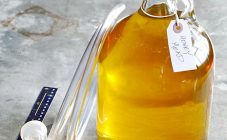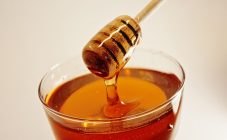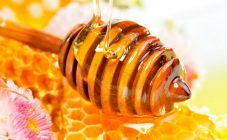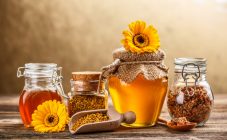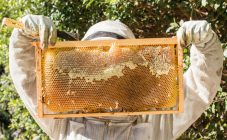Content:
The moisture content of honey is an indicator characterizing its maturity, reflecting the shelf life. Humidity divides honey into ripe and unripe honey. The first contains on average no more than 18-20% of water in the composition, everything above is immature, which cannot be stored for a long time. That is, long-term storage with unacceptable humidity levels is impossible.
Unripe honey is formed as a result of poor honey supply, or when it is extracted from unsealed combs. You can come across unripe honey when buying from an unscrupulous seller, who dilutes it with water or syrup in order to increase its volume.
Otherwise, honey will ferment at a rate depending on the yeast content. It is necessary to measure humidity at the stage of assembly, since honey crystals also contain some amount of water. It is necessary to store honey in a not very warm room, so as not to provoke the fermentation process. If the humidity is normal, then a temperature of 10 to 20 degrees is suitable for storage. If fermentation has begun, the storage temperature should not exceed 10 degrees. The room must be dry in any case.
Freeze-dried natural honey, for example, has a very low percentage of water. It is not meant for storage though.
How to determine, check the humidity at home
Experienced beekeepers determine the approximate moisture content by eye, according to the viscosity of honey. A more accurate method is a refractometer. This is a device for measuring the moisture content of honey at home. The measurement process should take place either during or immediately after harvesting the honey. After a short period of time, honey begins to crystallize and it is very difficult to measure the moisture level. And the result may be wrong.
If the inspection reveals immaturity at the stage of assembly, it is better to leave it to ripen for the required number of days. One of the methods of determination is getting rid of water and measuring weight loss with a hydrometer - another device for beekeepers.
If you take a spoonful of honey and slowly pour it out of it, then the stream will seem to be superimposed on each other. When stirring, the sweetness will form what is called a spiral. Also, the mature method is thicker and, if mixed, produces a quiet characteristic creak. The liquid composition will not have any squeaks, and the jet will begin to lay down crookedly, and the spiral will not be visible when stirring.
Another way is to put honey in a 1 liter container. The weight of the can will be 1400-1500 g. This result is at a humidity of 15-17%. These verification methods are available even to ordinary consumers who have not dealt with honey harvesting. Drying it will also not be difficult for them.
Hydrometer for honey
A refractometer is also called a moisture meter because it measures the percentage of moisture in the honey. This meter is a must for any beekeeper. If this device is not available, then the manufacturer (both large and private for their own consumption) runs the risk of being left without fresh product, since if you do not know the percentage of water, then you can determine the product in the wrong storage location. When the humidity is high, it is better to sell honey in small portions for quick consumption.
If the beekeeper has a moisture meter, he will be able to stop in time during assembly and allow the product to mature, or evaporate excess moisture and store at the correct temperature. The moisture meter works by the principle of lowering it into the fresh mass or by placing a few drops in a special cell. Outwardly, it looks a bit like a thermometer. Depending on the cost and manufacturer, moisture meters differ in speed and accuracy. The simplest ones are used by individuals who assemble for their own consumption. And in large apiaries, they use the most professional models and, often, in entire laboratories.
How to evaporate, remove water from honey
One way to preserve honey for a long time is to evaporate the water from it. This is done using the familiar water bath. True, this is applicable for the home. Again, larger apiaries use more innovative and faster methods. You can reduce the percentage of water at home.
It is worth evaporating honey by pouring it into a basin (steel or metal) and putting it on low heat. It is better to determine the time yourself, but usually it is at least 40 minutes.
The fact is that most of the moisture accumulates on the upper layers. In the very thickness, honey will remain as it was. A way out of the situation if it is not possible to do evaporation in a large vessel is to divide the mass of honey into smaller parts, or remove the top layer after it has been warmed up.
Sometimes it can be difficult to evaporate excess moisture from purchased honey. The fact is that unscrupulous sellers dilute honey with sugar syrup or water. If the purchased honey practically does not give off moisture, it means that it is diluted with syrup.
Storage and ripening of this natural sweetness should be provided in hermetically sealed containers. The lid must be tightly closed so that air and moisture do not enter.
Evaporation can also remove the light white layer. It occurs due to the large amount of glucose in the composition. True, there are few useful substances in it, and very few people will like this white layer in terms of taste.
How to evaporate honey from a can
You can put a large vessel, and pour water into it and place a can of honey. It is quite easy to evaporate honey at this rate, but for a long time. It is worth calculating the volume of the can: it is impossible to fill it completely, since it increases when heated. A closed can can even explode. During the evaporation process, some of the water is included in the crystallization process. But honey does not take more water than it needs.
You can also save honey that has begun to ferment by separating the watery part. The top layer may have more moisture than all other layers. If this phenomenon is observed during evaporation, then it is better to divide the sweetness into different vessels. Ripening at different levels occurs because honey begins to crystallize from below.
By the way, if it is decided to reduce the amount of water by evaporation, the total mass of honey will also decrease. Therefore, it is necessary to measure the mass with a special device before and after evaporation.
When sending honey for ripening, it is worth remembering that at the same time it loses some of its quality properties. It is not always possible to leave it in the hives. This could be due to moving, changes in weather conditions or other factors. If there is no such reason, it is better to leave the honey in the hives for several days.
During the ripening procedure, it will be effective to leave the whole mass in different containers with glass lids under the sun. This will help to evaporate excess moisture. But do not do this in hot weather if the temperature is above 20 degrees. The heat will only worsen the quality.
Normal, optimal honey moisture
As mentioned above, the normal humidity of honey is no more than 20 degrees. The optimum permissible humidity is from 16 to 20 degrees. But it is worth remembering that even ripe honey should be stored at a low temperature, since its useful substances are quickly destroyed in the heat.
It is desirable to store at a temperature not exceeding 20 degrees. For example, when stored at 10 degrees, sucrose will not break down for 9600 days, but at a temperature of 35 degrees, it will break down in 28 days. Since honey is obtained mainly in the Far East and Siberia, there are no storage problems.
Together with the destruction of nutrients, high temperatures also provoke the formation of harmful substances, for example, oxymethylfurfural. It is used in examinations for fake honey. The formation of OMP depends on the time and temperature of exposure, as well as on the acid index. Counterfeit honey contains foreign sugar that was not formed from this honey. Storage rooms should not only have a low temperature, but also a low humidity.
What is worth saying about mature and unripe honey is that each has benefits. For example, some people prefer unripe honey more. It is more convenient to use it for cosmetic masks and baked goods. True, there are less useful properties in it than in mature.
Mature can be eaten and stored for a long time. It helps in the prevention of diseases and sore throat. Also, it is very healthy and full of vitamins. It is eaten instead of sweet and added to tea instead of sugar.
In the modern market, the sold honey must strictly comply with GOST, where the level of permissible moisture content of the composition is prescribed. All of the above applies to classic honey, but there are many more varieties and requirements for them may vary. Lovers of different types of honey are recommended to have a personal refractometer at home for their own confidence in the quality of the product. All information provided is current for 2018.




